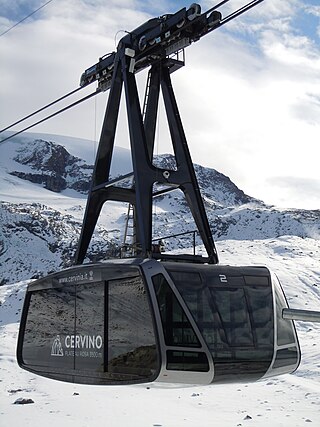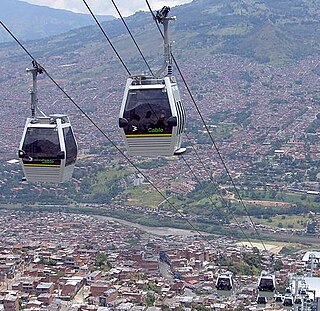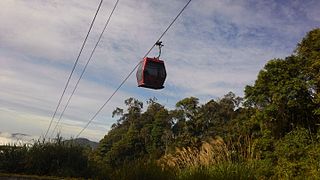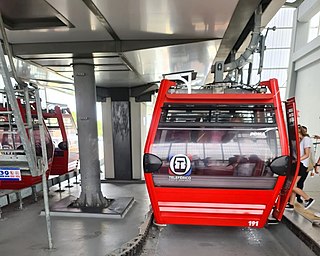
An aerial tramway, aerial tram, sky tram, aerial cablecar, aerial cableway, telepherique, or seilbahn is a type of aerial lift which uses one or two stationary ropes for support while a third moving rope provides propulsion. With this form of lift, the grip of an aerial tramway cabin is fixed onto the propulsion rope and cannot be decoupled from it during operations. In comparison to gondola lifts, aerial tramways generally provide lower line capacities and higher wait times.

A gondola lift is a means of cable transport and type of aerial lift which is supported and propelled by cables from above. It consists of a loop of steel wire rope that is strung between two stations, sometimes over intermediate supporting towers. The cable is driven by a bullwheel in a terminal, which is typically connected to an engine or electric motor. It is often considered a continuous system since it features a haul rope which continuously moves and circulates around two terminal stations. In contrast, an aerial tramway operates solely with fixed grips and simply shuttles back and forth between two end terminals.

A funitel is a type of cableway, generally used to transport skiers, although at least one is used to transport finished cars between different areas of a factory. It differs from a standard gondola lift through the use of two arms attached to two parallel overhead cables, providing more stability in high winds. The name funitel is a portmanteau of the French words funiculaire and telepherique.

An aerial lift, also known as a cable car or ropeway, is a means of cable transport in which cabins, cars, gondolas, or open chairs are hauled above the ground by means of one or more cables. Aerial lift systems are frequently employed in a mountainous territory where roads are relatively difficult to build and use, and have seen extensive use in mining. Aerial lift systems are relatively easy to move and have been used to cross rivers and ravines. In more recent times, the cost-effectiveness and flexibility of aerial lifts have seen an increase of gondola lift being integrated into urban public transport systems.

The Medellín Metro is a rapid transit system that crosses the Metropolitan Area of Medellín from North to South and from Centre to West. It first opened for service on 30 November 1995. As one of the first implementations of modern mass transportation in Colombia and the only metro system in the country, the Medellín Metro is a product of the urban planning of the Antioquia department of Colombia. It is part of the Aburrá Valley Integrated Transport System.

The Schauinslandbahn is a gondola lift in the Black Forest area of Baden-Württemberg, Germany. It links a lower station in the municipality of Horben, near the city of Freiburg im Breisgau, with an upper station near the summit of the Schauinsland mountain. The line is operated by VAG Freiburg, the city transport operator for Freiburg. The same company operates that city's tram and bus network, including bus route 21 that links the lower station of the Schauinslandbahn to the terminus of tram route 2 at Günterstal.
Poma, incorporated as Pomagalski S.A., and sometimes referred to as the Poma Group, is a French company which manufactures cable-driven lift systems, including fixed and detachable chairlifts, gondola lifts, funiculars, aerial tramways, people movers, and surface lifts. Poma has installed about 7800 devices for 750 customers worldwide.

The tricable gondola lift, also known as the 3S gondola lift, is a cable car system that was developed by the Swiss company Von Roll transport systems in Thun to unite the benefits of a gondola lift with those of a reversible cable car system. '3S' is an abbreviation of the German word dreiseil, meaning 'tricable'.

Metrocable is a gondola lift system implemented by the City Council of Medellín, Colombia, with the purpose of providing a transportation service that complements the Medellín Metro. It was designed to reach some of the city's informal settlements on the steep hills that mark its topography. It is largely considered to be the first urban cable propelled transit system in South America. The transportation infrastructure is already established and has been in service since 2004.

The Teleférico de Caracas is a gondola lift that ascends El Ávila Mountain within El Ávila National Park, in Caracas, Venezuela.

The Tbilisi cable car crash was an aerial tramway accident in Tbilisi, the capital of Soviet Georgia on 1 June 1990, which resulted in 19 deaths and at least 42 injuries.

Arví Park is both an ecological nature preserve and Pre-Hispanic archeological site on the eastern slopes of Aburrá Valley, in the northeast area of Medellín, Colombia. The park covers several other municipalities of Antioquia, including Envigado, Bello, and Copacabana. It covers 16,000 hectares, 1,760 of which are in the state of natural forests. And it is equipped with 54 miles of walkable trails. It is a major tourist attraction, known for its wildflowers, butterflies and trails. Activities include hiking, nature tours, cycling, and outdoor adventure sports. An outdoor food market is located next to the gondola station. The Piedras Blancas Ecological Hotel and its private reserve are adjacent to the park.

The Olympos Aerial Tram, aka Olympos Cable Car, is an aerial lift of tramway type located in Antalya Province, southern Turkey, serving the peak of Mount Olympos at an altitude of 2,365 m (7,759 ft) from Kemer. It went into service in 2006.

The Awana Skyway, also referred to as the new Awana Skyway, is a gondola lift system connecting Awana Transport Hub, Chin Swee Temple and SkyAvenue in Genting Highlands, Pahang, Malaysia since December 2016. The Awana Transport Hub terminus consists of the new Awana Bus Terminal, the station building and a new 8-storey car park while the other terminus is located at SkyAvenue.

TransMiCable is a gondola lift system implemented by the city of Bogotá, Colombia, with the purpose of providing a complementary transportation service to TransMilenio. Line T, with a length of 3,34 km and four stations, connects the Portal del Tunal (TransMilenio) station to Mirador del Paraíso station in the steep hills of Ciudad Bolívar district and was opened on 27 December 2018. It is part of the city's Integrated Public Transport System, along with TransMilenio and the urban, complementary and special bus services operating on neighbourhoods and main streets.

The Teleférico de Santo Domingo is an aerial cable car urban transit system in Greater Santo Domingo, operated as part of the Santo Domingo Metro. It is the first urban-transport aerial cable car line in the Dominican Republic. It functions as a typical monocable gondola, and runs for 5 kilometers and a total of four stations, and is connected to the Santo Domingo metro system.

SITVA is the public transportation system of Medellín and its metropolitan area. It allows people from the Metropolitan Area of Medellín to move across the ten Aburrá Valley municipalities using different transport modes. It uses integrated fares and a single payment card.

The Sistema de Transporte Público Cablebús, simply branded as Cablebús, is an aerial lift transport system that runs in the Gustavo A. Madero and Iztapalapa areas of Mexico City. It is operated by Servicio de Transportes Eléctricos, the agency responsible for the operation of all trolleybus and light rail services in Mexico City. Line 1 was officially inaugurated on 11 July 2021, going from the Indios Verdes station of the STC Metro to the northern neighborhoods of Gustavo A. Madero. Line 2 runs from the Constitución de 1917 to the Santa Marta STC Metro stations in the southeast of the city.



















